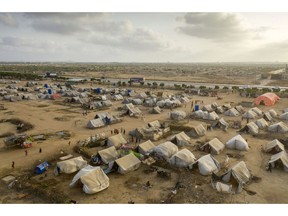Pakistan’s record flooding last year displaced millions and left the country reeling. As a new monsoon season approaches, recovery efforts are floundering.
Coco Liu and Faseeh Mangi
Published Jul 02, 2023 •

The refugee camp outside Karachi in May. "The already difficult living conditions of people affected by the 2022 flooding in Pakistan have been further exacerbated by the rain, making them even more vulnerable to future flooding," the UN noted in a recent report.
Photographer: Asim Hafeez/Bloomberg Bloomberg RSS
Article content
(Bloomberg) — When night falls in the refugee camp outside Karachi, Shanawaz Khoso worries about snake bites. The 38-year-old and his seven children sleep in tents alongside 5,000 other displaced villagers, partially exposed to the elements and to creatures that include scorpions and venomous snakes. When the sun rises, stifling heat and mountains of untreated sewage turn the camp into a breeding ground for disease. Fever and stomach pain are prevalent, but there are no doctors and there is no medicine.“We are living here out of necessity,” Khoso says. “Nothing is coming here now. We’re terrified.”
With monsoon season fast approaching, Pakistan has already seen heavy rains and strong winds resulting in dozens of fatalities, hundreds of injuries and damage to roads, houses and farmland. This year, though, the rain is falling on a country still reeling. Just 10 months ago, severe flooding in Pakistan killed over 1,700, displaced 8 million and cost the economy more than $30 billion.
Now crop shortages linger, thousands remain homeless and the country is struggling with rebuilding, food supply, health care and debt. Relief aid has largely dried up. As new rains threaten the same areas hit by last year’s floods, Pakistan finds itself at the mercy of a pernicious pattern: Climate change is driving more intense rainfall, which drives more intense flooding, which stymies recovery from past floods.
It’s a paradigm familiar to the other eight countries in what’s known as the Third Pole, which is facing the impacts of warmer air on both monsoons and melting mountain ice. Glaciers in Asia’s Hindu Kush Himalayan region could lose 80% of their current volume by the end of this century, according to a recent study, threatening the livelihoods of as many as 2 billion people downstream — roughly a quarter of the world’s population. Without effective mechanisms to finance their own recoveries, let alone prepare for future climate crises, developing nations are particularly unprepared. “Pakistan is an avatar for what happens when climate-vulnerable countries that are not climate-resilient are in the firing line of changed weather conditions,” says David Miliband, president of International Rescue Committee, a humanitarian aid group. “They’re on the front lines of something that’s going to be faced by other countries.”
Article content
(Bloomberg) — When night falls in the refugee camp outside Karachi, Shanawaz Khoso worries about snake bites. The 38-year-old and his seven children sleep in tents alongside 5,000 other displaced villagers, partially exposed to the elements and to creatures that include scorpions and venomous snakes. When the sun rises, stifling heat and mountains of untreated sewage turn the camp into a breeding ground for disease. Fever and stomach pain are prevalent, but there are no doctors and there is no medicine.“We are living here out of necessity,” Khoso says. “Nothing is coming here now. We’re terrified.”
With monsoon season fast approaching, Pakistan has already seen heavy rains and strong winds resulting in dozens of fatalities, hundreds of injuries and damage to roads, houses and farmland. This year, though, the rain is falling on a country still reeling. Just 10 months ago, severe flooding in Pakistan killed over 1,700, displaced 8 million and cost the economy more than $30 billion.
Now crop shortages linger, thousands remain homeless and the country is struggling with rebuilding, food supply, health care and debt. Relief aid has largely dried up. As new rains threaten the same areas hit by last year’s floods, Pakistan finds itself at the mercy of a pernicious pattern: Climate change is driving more intense rainfall, which drives more intense flooding, which stymies recovery from past floods.
It’s a paradigm familiar to the other eight countries in what’s known as the Third Pole, which is facing the impacts of warmer air on both monsoons and melting mountain ice. Glaciers in Asia’s Hindu Kush Himalayan region could lose 80% of their current volume by the end of this century, according to a recent study, threatening the livelihoods of as many as 2 billion people downstream — roughly a quarter of the world’s population. Without effective mechanisms to finance their own recoveries, let alone prepare for future climate crises, developing nations are particularly unprepared. “Pakistan is an avatar for what happens when climate-vulnerable countries that are not climate-resilient are in the firing line of changed weather conditions,” says David Miliband, president of International Rescue Committee, a humanitarian aid group. “They’re on the front lines of something that’s going to be faced by other countries.”
No comments:
Post a Comment